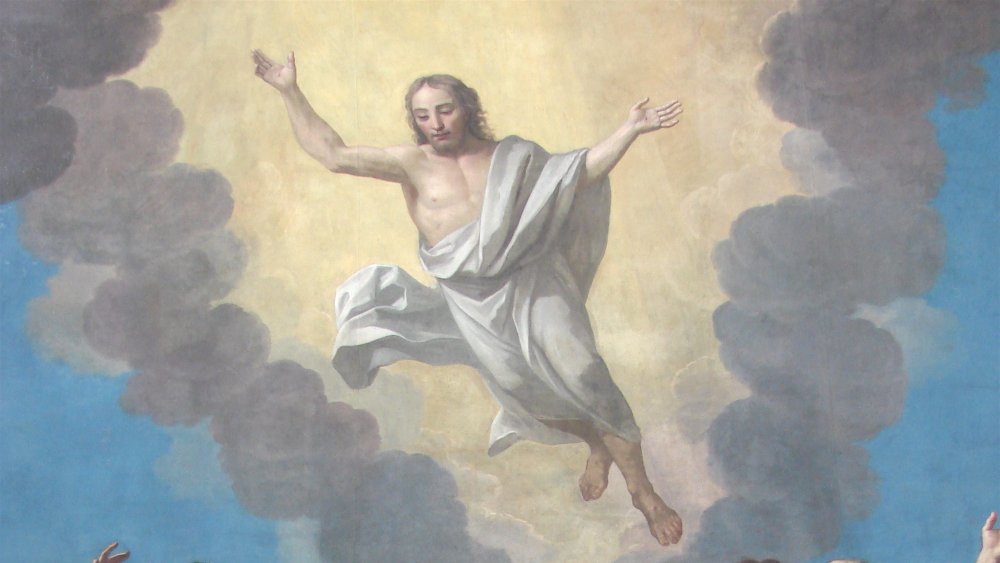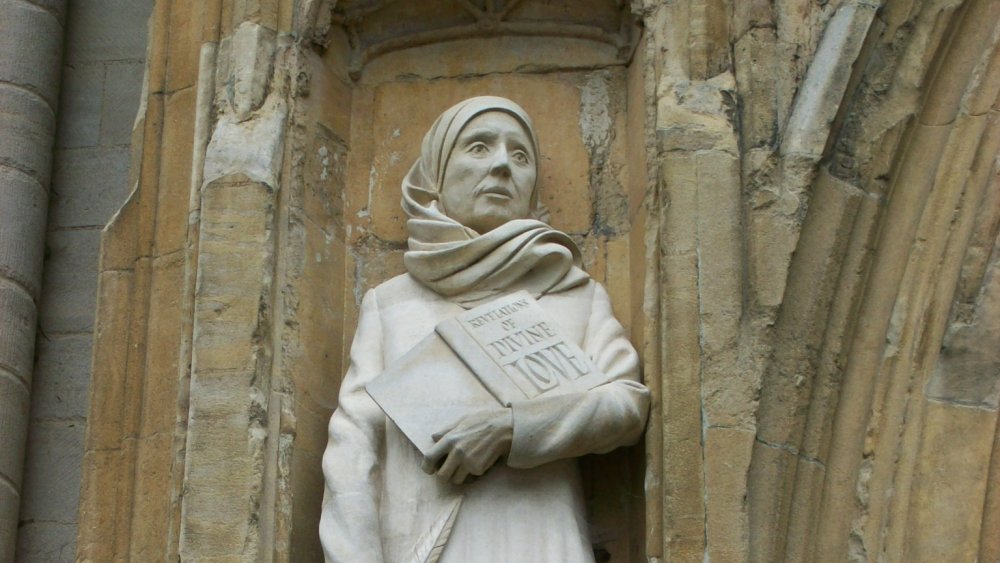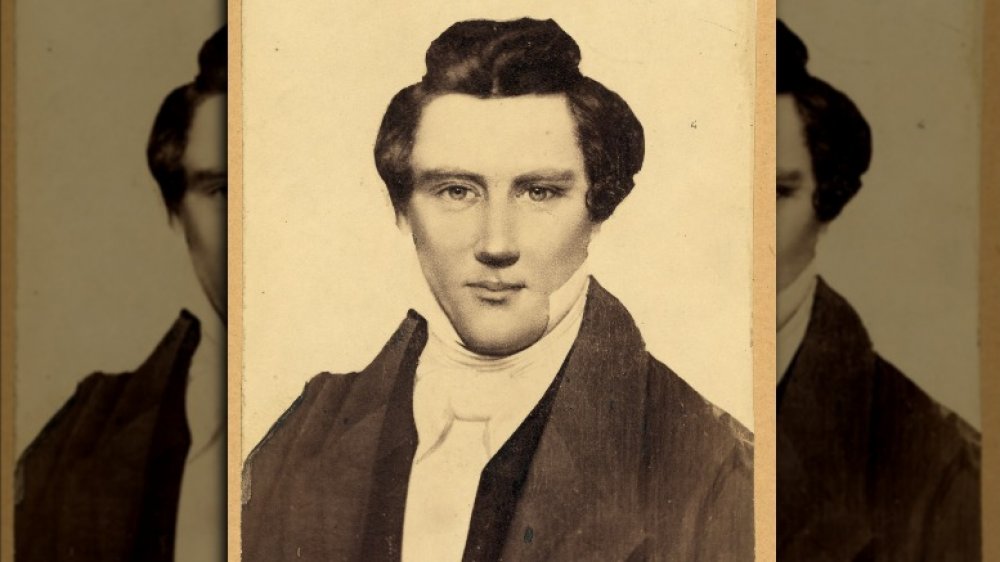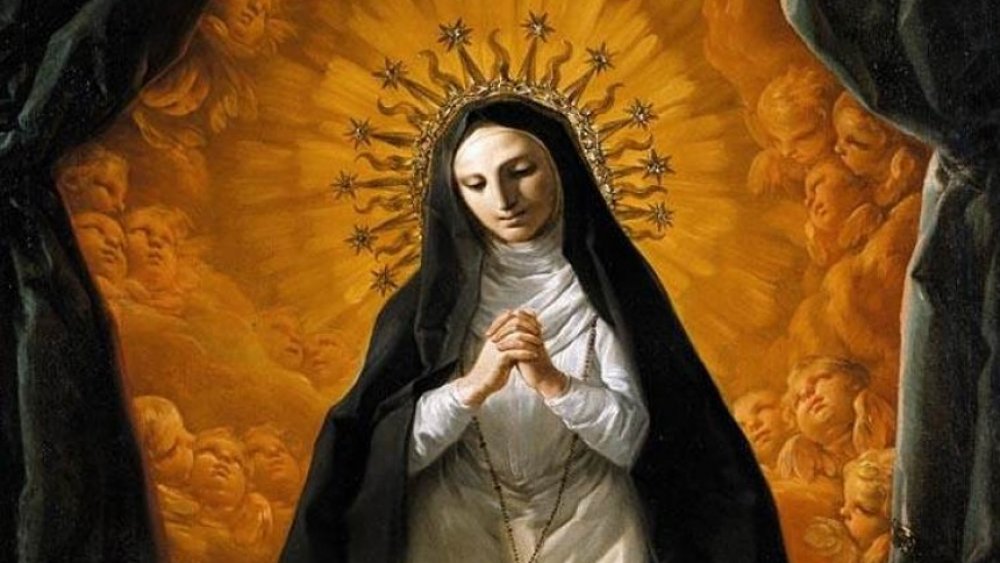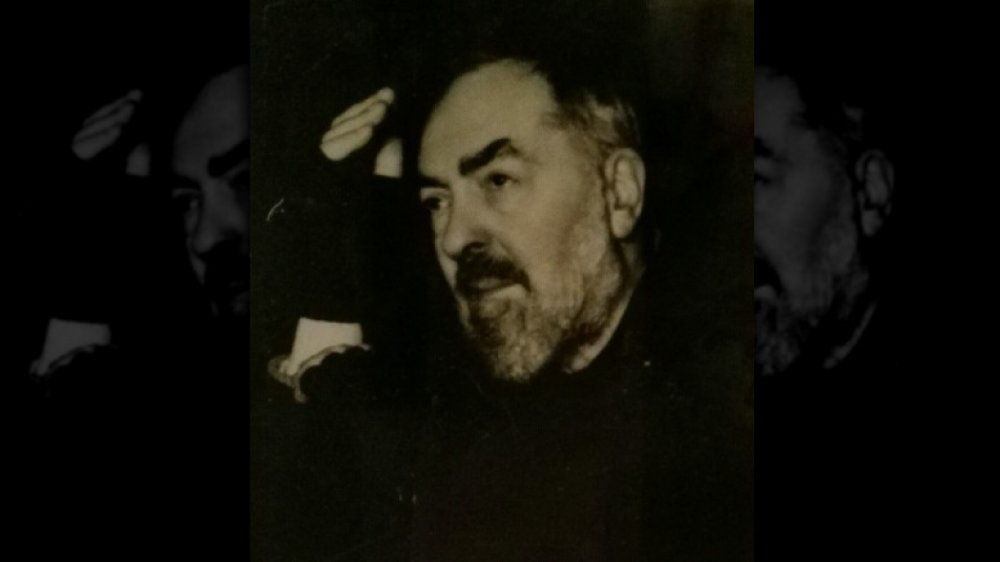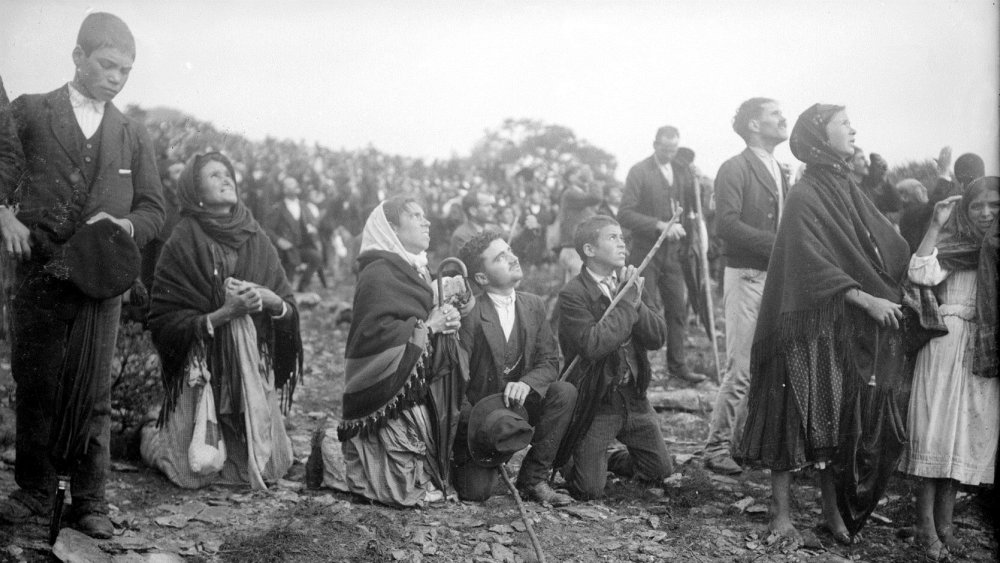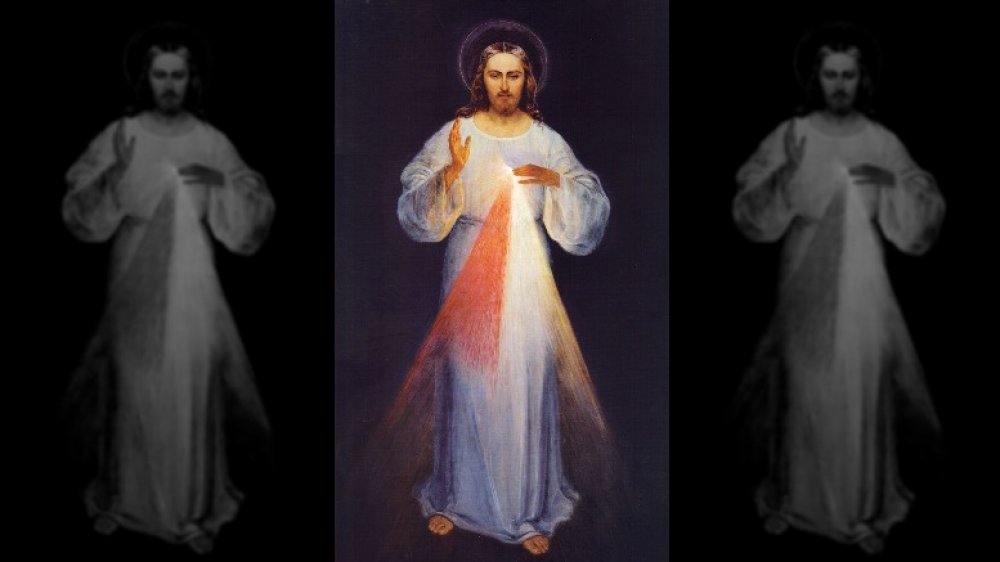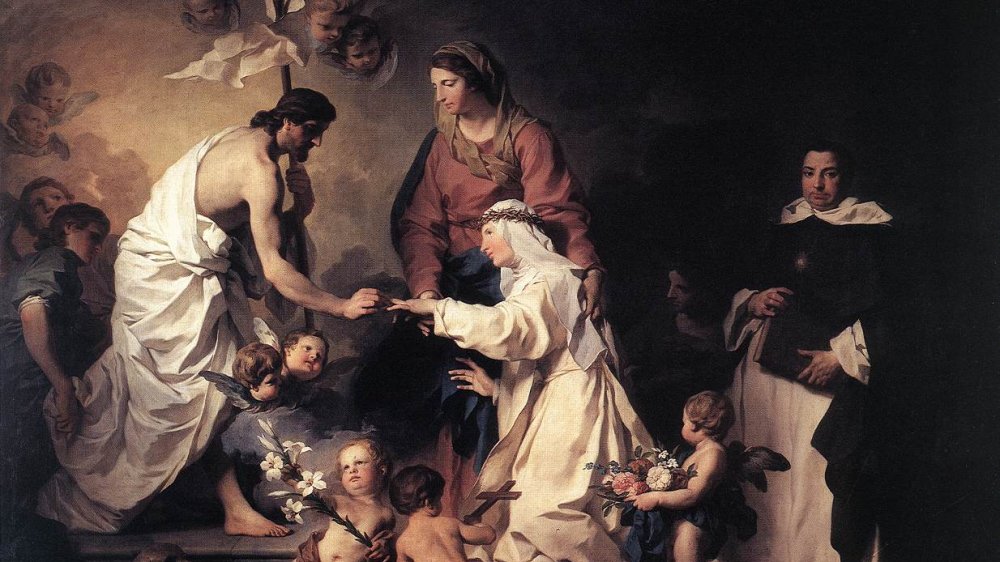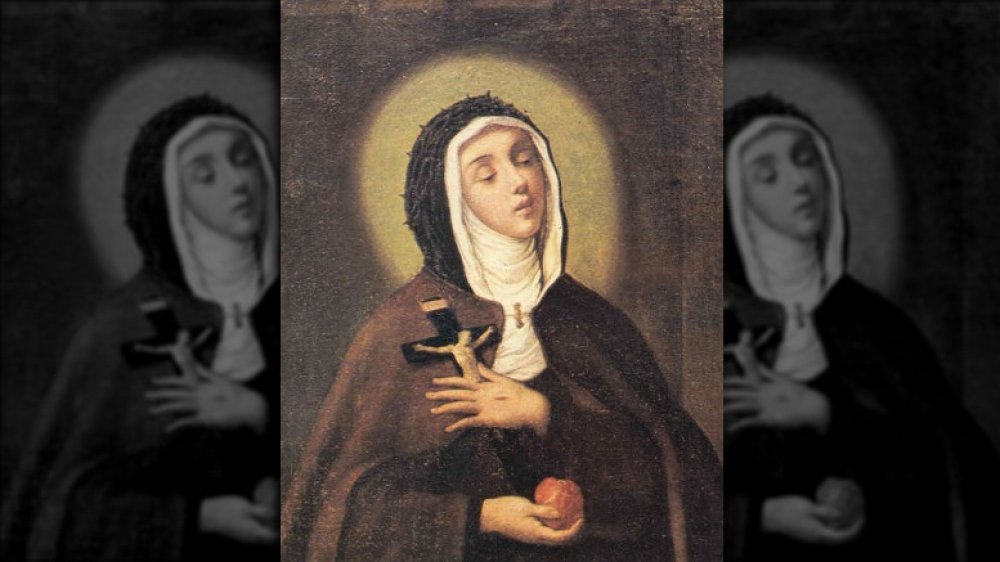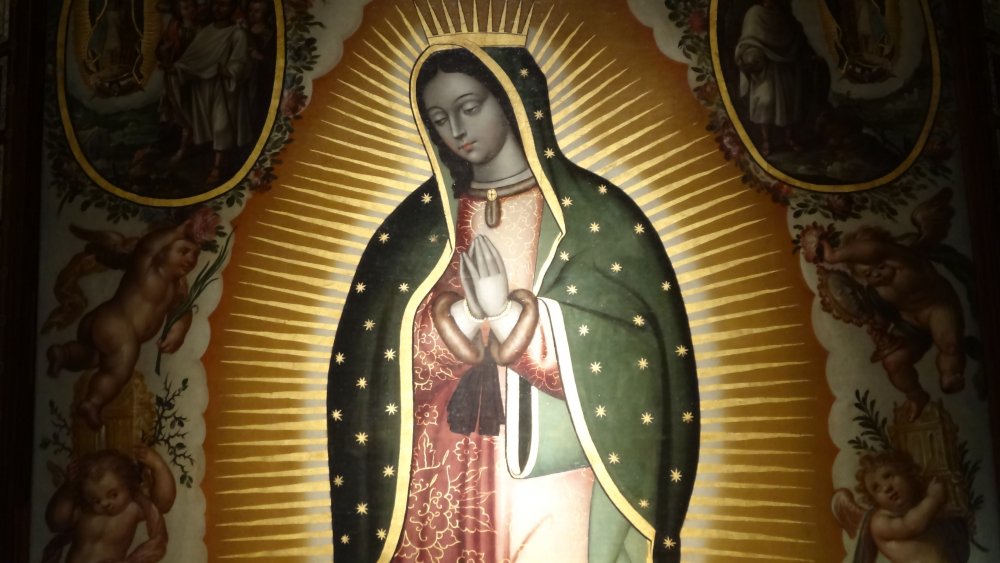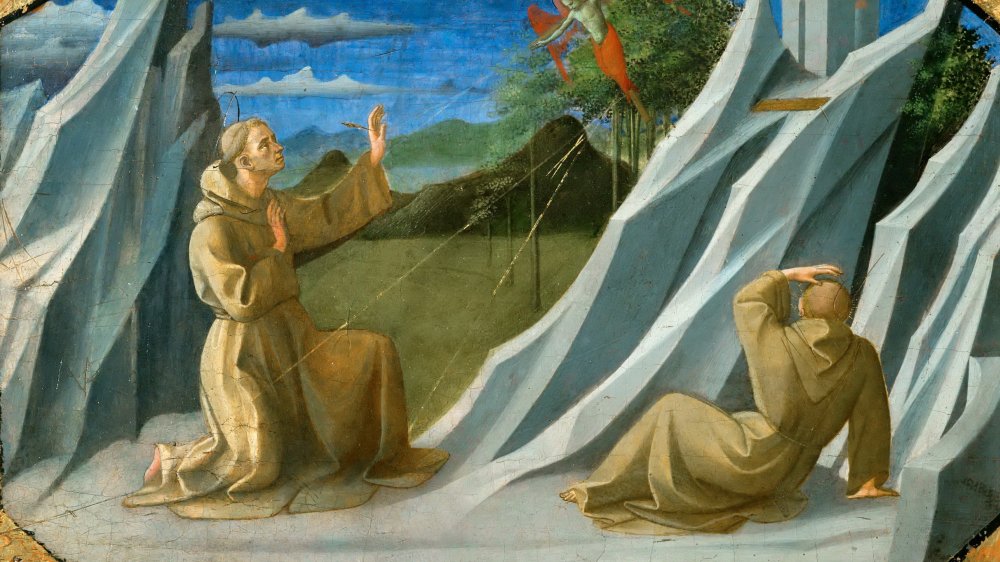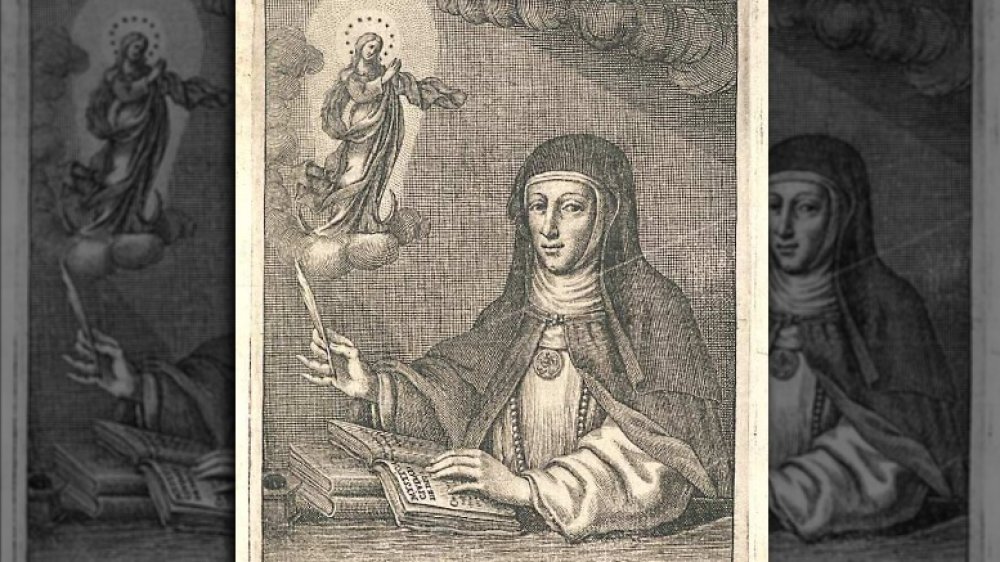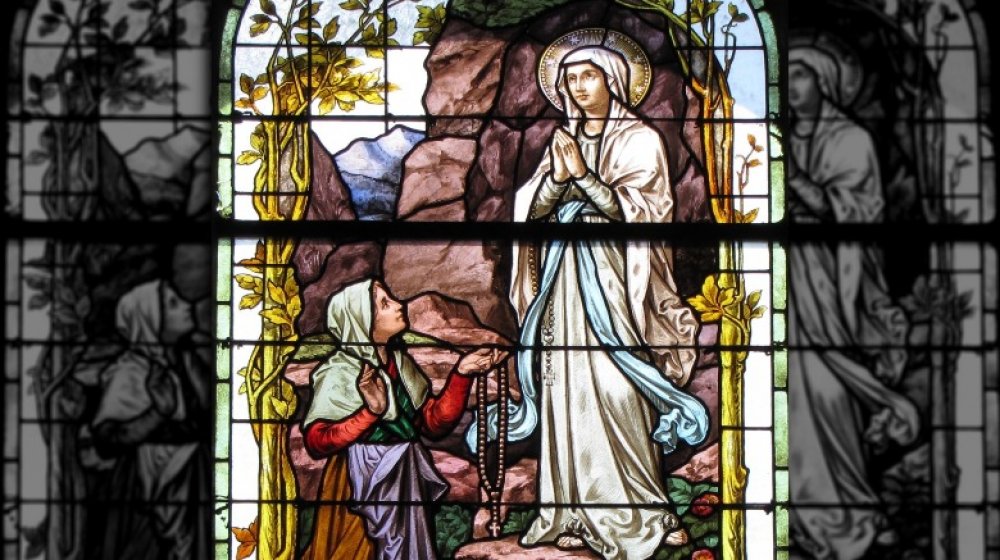The Most Famous Visions Of Jesus And Mary In History
Visions of Jesus and his mother, Mary, have been with Christianity since its very beginning. The very first account of a divine encounter with a post-crucifixion Jesus is related in the Gospel of John. In it, Jesus has died on the cross, has been resurrected, and has begun appearing to his followers. Though some of his followers were said to have witnessed the returned Jesus, the Apostle Thomas wasn't with them at the time. He remained highly skeptical, saying he wouldn't believe it until he could see Jesus for himself and identify the wounds his leader had received on the cross. Jesus appeared and, to really make sure Thomas got it, allowed his disciple to touch the wound in question.
Later visions focusing on Jesus and Mary were also very visceral. Sometimes, they were even downright gory. Other accounts have proven to be more pretty, with less gore and more inspiring messages of divine love accompanied by roses.
Lest you think that all these visions are easily dismissed accounts of people seeing the Savior on their morning toast, some of these reported encounters have left profound marks on history. A few visions of Jesus and Mary are so famous that entire national identities and personal faiths have been built up on the foundation of a mystical experience.
Julian of Norwich was walled into a church after seeing Jesus
Though Julian of Norwich is the first known woman to write a book in English, we know very little about her life. According to the British Library, we do know that she experienced great upheaval while living in Norwich, England, including plague, revolts, and illness. Her own work, Revelations of Divine Love, gives only the barest outline of Julian herself, but it does explain the visions that changed her life.
In Revelations, Julian says that she was about 30 years old in 1373 when she became seriously ill. Thinking that she was at the edge of death, a priest came to her bedside and held a cross before her. There, she received a bloody, dramatic vision of the crucified Christ. Over the next day and night, she had a series of 15 more divine encounters. Shortly after her recovery, says Britannica, Julian began to commit these "shewings" to paper.
Either before or shortly after her illness, Julian committed herself as an anchoress. An anchoress, says the British Library, was a religious person who voluntarily lived walled up in a small cell. Julian's enclosure was attached to Norwich Cathedral. She lived the rest of her life in this single room, with a window looking into the sanctuary and one onto a busy street. When she wasn't dispensing advice to the people of Norwich via one window, she was likely mulling over her visions and writing Revelations.
Joseph Smith claimed to receive instructions directly from Jesus
Joseph Smith was the founder of the Church of Jesus Christ of Latter-day Saints. But, before he gathered together any followers in the 19th century, he was just another person living in western New York state. That all changed in 1820.
That year, says Dialogue: A Journal of Mormon Thought, Joseph claimed to have encountered two divine beings he identified as Jesus Christ and God the Father. Previously, he had been deep in prayer, agonizing over the correct religious path. In fact, there were many. At that point in American history, reports New York Heritage, western New York was so roiled by religious revivals and new ideas that it came to be known as the "Burned-Over District."
For Mormons, this "First Vision," as it came to be known, would stand out among the religious noise. The first known written account, in Smith's hand, was produced in 1832, says the LDS Church. It relates a vision where Jesus appeared and forgave Joseph of his sins. The Lord then said that "mine anger is kindling against the inhabitants of the earth," as other folks were apparently so unholy that an apocalypse was brewing.
Though many are skeptical about all of Joseph Smith's accounts, the First Vision remains a foundational part of LDS belief. It was so monumental that, either way, it spawned a highly successful new church that's been around for nearly 200 years.
Margaret Mary Alacoque got very close to Jesus
Saint Margaret Mary Alacoque, a French nun born in 1647, is best known for her promotion of the Sacred Heart of Jesus. The devotion to the Sacred Heart is today a widely practiced Catholic custom of worship, says Britannica. It focuses on the heart of Jesus as an object of veneration, with mystical details like a crown of thorns encircling the heart while light emanates from the organ. The idea has been around for centuries, but if not for Sister Margaret Mary, it might have remained obscure.
As a teenager, Margaret hadn't fully committed herself to her faith. That changed when, after a party, she had a vision of a bloody and suffering Christ. As related by Catholic Online, the vision chastised Margaret for living a life sliding toward intemperance. He then showed his heart to the young woman. Margaret recommitted herself to her faith and took steps to become a nun.
Throughout her time as a religious sister, she continued to have mystical visions of Jesus. In 1673, she said that he appeared to her and allowed Margaret Mary to lay her head directly on his heart. In the same vision, she was told that the fleshy human heart of Jesus was supposed to act as an allegory for his divine love for all humanity. Her championing of the Sacred Heart devotion was still controversial after her 1690 death but was officially sanctioned many decades later.
Padre Pio said he received stigmata after his vision
In 1911, Italian friar Padre Pio began claiming that he had received stigmata, or gory marks representing the wounds Christ received on the cross. According to the BBC, doctors could never find a good explanation for the marks. They never seemed to heal, but neither did the open wounds become infected. The faithful took this as a sign that the stigmata were divinely granted to the padre as a mark of great piety.
Pio, who was made a saint by Pope John Paul II in 2002, according to the Vatican, is credited with two officially recognized miracles. He was also supposedly able to bilocate, or appear in two places at once, and was renowned for his healing abilities, says Britannica.
Some are skeptical of his dramatic story, however. The Skeptical Inquirer claims that stories like those focusing on his miraculous healing ability are difficult, if not totally impossible, to prove. And the stigmata, the centerpiece of Padre Pio's veneration and the signs that catapulted him to religious stardom? Some accused the priest of inflicting them upon himself with acid.
Our Lady of Fátima reportedly visited children and messed with the sun
In 1916, three poor children herding sheep near Fátima, Portugal, said they were visited by an angel. The trio, including nine-year-old Lúcia dos Santos and her cousins, Francisco and Jacinta Marto, maintained that they were visited by an angel three times, says EWTN. The heavenly being told them to adore the Lord and pray.
In the spring of 1917, the children began to tell others that they had also been visited by a "Lady more brilliant than the sun," reports When the Sun Danced. The "Lady" told them she was from heaven and that she needed them to pray every day in order to end the war. World War I, then ravaging Europe, wouldn't end until late 1918.
Word of the apparitions soon got out to the entire village. This all culminated in what was supposed to be the last apparition on October 13, 1917. A crowd of thousands of people gathered in Fátima. Some witnessed the "miracle of the sun," says When the Sun Danced, where the light turned strange and the sun whirled about the sky. Yet some, including believers, reports EWTN, witnessed only odd lights or nothing at all.
Afterward, says the Catholic News Agency, Francisco and Jacinta died of influenza. Lúcia, who lived be 97, became a Carmelite nun and published her memoirs, Fátima in Lúcia's Own Words.
Sister Faustina saw the King of Divine Mercy
Like many religious figures, Poland's Sister Faustina Kowalska claimed to have had a deep and abiding faith since early childhood. She even wanted to become a nun when she was just a teenager, says Catholic Online, but her impoverished parents pushed her to become a housekeeper. That changed in 1924, when she saw a vision of Jesus in pain while she was at a dance. Jesus later told her to leave Warsaw, where she had been living, and to join a convent as quickly as possible.
Faustina tried just that, though it took many attempts before a convent accepted her. She finally became a nun in 1926, joining the Sisters of Our Lady of Mercy. It seemed like she would live a simple life, traveling between convents as a cook, before she began to grow ill and was told to rest.
It was in this state that Faustina claimed to have been visited by Jesus yet again. In her diary, she wrote that he appeared to her dressed in white, with one hand raised to bless her and the other touching his chest, which emanated one red and one white light. She says that he then told her to "paint an image according to the pattern you see, with the inscription: Jesus, I trust in You."
She did just that. The image became widely popular among worshipers, inspiring the devotion to the Divine Mercy that's still in use among Catholics today.
Catherine of Siena had intense mystical visions of Jesus
Catherine of Siena was born in 1347 to a large and relatively prosperous family. From a young age, she claimed to have religious visions and appeared dedicated to denying herself even the most basic needs, such as food, reports ThoughtCo.
Her family was all set to marry her off to her sister's widower when Catherine dropped a bombshell: She had already committed her virginity to God. Her parents allowed her to join the Sisters of Penance of St. Dominic in 1363. She became a tertiary sister, meaning that she was allowed to stay in her family's home. Far from going easy on herself, Catherine stayed in her room and only spoke to her confessor.
Around 1367, Catherine experienced what would be one of her most famous visions. As reported by Catholic Exchange, she experienced a "mystical marriage," where Christ took her as his spiritual bride. According to Catherine's account, the wedding party included famous figures like King David, Saint Paul, Saint John the Evangelist, and the Virgin Mary. Jesus, she says, presented her with a wedding ring made out of his own flesh. Catherine said that only she could see the ring, which reportedly stayed on her hand, though invisible to others, for the rest of her life.
Veronica Giuliani showed marks of the crucifixion
Born in 1660 in central Italy, Veronica Giuliani seemed all set to be the unremarkable daughter of a comfortable but unremarkable family. Like many other children of her time and place, Veronica, who was baptised and first known as Orsola, received a deep and complex religious education. And like so many other saints, Veronica was entrenched in a tradition of sometimes extreme self-denial. According to the University of Chicago Library, her entire philosophy was based on this suffering in search of reaching a deeper relationship with the Divine.
In one of her earliest visions, a three- or four-year-old Veronica saw the infant Jesus gathering flowers in her family's garden. He then told her, "I am the true flower." When Veronica joined the Capuchin order in 1677, she was to encounter more trouble. After a disagreement with her mother superior, she was reported to the Vatican in 1697 and made to undergo intense questioning and physical inspections.
At one point, she was forced to learn how to write in order to record her visions. She produced thousands of pages describing further mystical experiences, says the Vatican, including accounts of being crowned with thorns, receiving stigmata, and her mystical marriage to Christ.
Our Lady of Guadalupe strengthened Catholicism in Mexico
Juan Diego was just trying to get to church. It was December 1531, though, as Mexican Phoenix: Our Lady of Guadalupe reports, the first published accounts of this event didn't hit the presses until 1648. Diego, an indigenous man, was near the Hill of Tepeyac when he saw a young woman. She spoke to him in the local Nahuatl language, telling him that she was the Virgin Mary.
When Juan Diego approached the archbishop of Mexico City with his story, the church elder was skeptical. Mary appeared to Diego again, telling him to stay the course. She showed herself a total of four times, finally consenting to give a sign to convince the archbishop. She told Diego to gather roses that had bloomed nearby. He collected them in his tilma, or cloak. When he opened the tilma in front of the archbishop, the roses spilled out, revealing an image of the Virgin miraculously imprinted on the cloth.
Our Lady of Guadalupe, as she came to be known, is now so central to Catholic belief in the region that she's become the patron saint of Mexico, says Britannica. Juan Diego's tilma is still on display in the Basilica of Guadalupe. Though some still have questions about the image and how it was made, NBC reports that Our Lady of Guadalupe was such an important vision that she is still a powerful symbol of Mexican identity more than four centuries later.
St. Francis left everything after he claimed to see Jesus
Today, Saint Francis of Assisi is the poster boy for pious poverty. He founded the Franciscans, a group of religious orders that holds worldly wealth at a distance. Yet, for the young Francis, it wasn't always that way.
According to Biography, he was born around 1181 in Italy, the son of a wealthy family. When he took part in a battle, Francis was captured by enemy forces and spent almost a year in prison. During that time, he reportedly began to receive visions from God that intensified upon his release in 1203. Confinement had turned the spoiled young aristocrat into a somber man. He began to focus intensely on religion. While at the church of San Damiano, it's said that he heard the voice of Christ, who told him to rebuild the church and to embrace a life of extreme poverty.
Later in life, while deep in prayer, says Britannica, he saw a figure approaching him from above. According to the account, it was a seraph, or angel, with six wings who was nailed to a cross. Francis, overcome by the beauty and intensity of this vision, took this as a sign that he would receive stigmata. These wounds, which are said to mimic the wounds received by Christ on the cross, appeared on his feet and hands. Francis reportedly concealed them until his death, when a fellow monk finally told the rest of the world.
María de Jesus de Ágreda says the Virgin Mary dictated a book to her
María Fernandez Coronel, now better known as María de Jesus de Ágreda, was born in Ágreda, Spain, in 1603, says Britannica. As a nun, she had complex visions, which, according to María of Ágreda, got her into considerable trouble. She claimed to have been approached by the Virgin Mary herself, who dictated a book to Sister María. That book, The Mystical City of God, generated plenty of controversy both before and after María's death, says the University of Dayton.
Sister María is rumored to have appeared as a vision herself. According to the National Park Service, she was supposedly able to bilocate, or appear in two locations at once. In 1620, she reported that, while in a trance in her convent, she had traveled across the Atlantic Ocean and visited the Jumano tribe of what is now Texas and New Mexico. Later, Native people are recorded as visiting Spanish missions in the area because a "Lady in Blue" had appeared and told them to do so. The color of María's habit, as it was for other Franciscan nuns, was blue.
A vision of Mary made Lourdes a pilgrimage spot
The story of Lourdes, France, and its apparition of the Virgin Mary began with 14-year-old Bernadette Soubirous. According to Britannica, Bernadette was the eldest child in a large, poverty-stricken family. She was sickly, suffering from cholera, asthma, and a suite of other illnesses throughout her relatively short life. When the teenage girl visited a nearby grotto in February 1858, she was greeted with an apparition of the woman, accompanied by the words, "I am the Immaculate Conception." The woman, who later revealed herself as the Virgin Mary, told the girl to build a chapel in the very spot.
Bernadette quickly communicated the message, but most of the adults in her life were highly skeptical. To bolster the claim, Bernadette maintained that she had experienced a series of visits from the Virgin at the grotto. As outlined by the Lourdes Sanctuary, these visitations continued through July 1858 and included miraculous healings when people plunged various body parts into the grotto's spring. They also included what sound like awkward, silent visits, where Bernadette prayed while hundreds of people watched.
Eventually, Bernadette entered into a convent and died at the age of 35, maintaining the truth of her visions to her dying day. Lourdes and the grotto became a popular pilgrimage site, says Lourdes: Body and Spirit in the Secular Age. Thousands of people have visited the spring, with some saying that the water has miraculously cured their previously untreatable ailments.
